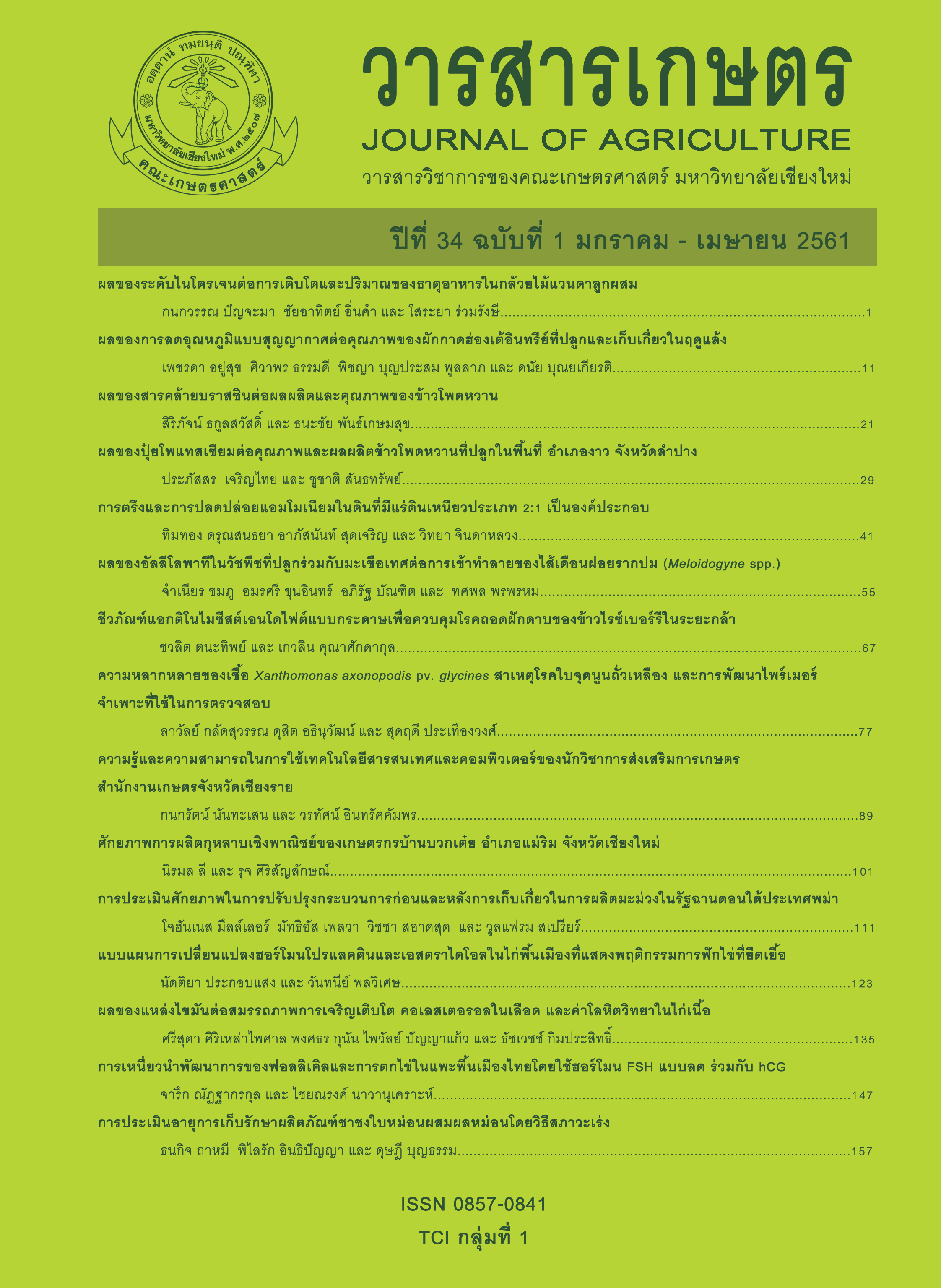ผลของอัลลีโลพาทีในวัชพืชที่ปลูกร่วมกับมะเขือเทศต่อการเข้าทำลาย ของไส้เดือนฝอยรากปม (<I>Meloidogyne</I> spp.)
Main Article Content
บทคัดย่อ
ไส้เดือนฝอยรากปม (Meloidogyne spp.) เป็นศัตรูพืชสาเหตุรากปมที่สำคัญของพืชเศรษฐกิจหลายชนิด โดยมีรายงานว่าวัชพืชซึ่งเป็นศัตรูพืชที่สำคัญในการแก่งแย่งปัจจัยที่ในการเจริญเติบโตกับพืชปลูก และเป็นพืชอาศัยของไส้เดือนฝอยรากปมได้อีกด้วย การทดลองนี้จึงมีวัตถุประสงค์เพื่อศึกษาผลของวัชพืช จำนวน 7 ชนิด ที่ปลูกแบบเดี่ยวและปลูกร่วมกับมะเขือเทศต่อการเกิดรากปมและความมีชีวิตรอดของไส้เดือนฝอย สำหรับเป็นข้อมูลและแนวทางในการเลือกจัดการวัชพืชที่พบขึ้นในแปลงของพืชปลูก ผลการทดลองพบว่า กะเม็ง และผักละออง มีการเกิดรากปม จึงเป็นวัชพืชอาศัยที่ดีของไส้เดือนฝอย ส่วนแห้วหมูเป็นวัชพืชที่ไม่มีการเกิดรากปม แต่เมื่อปลูกร่วมกับมะเขือเทศทำให้ไส้เดือนฝอยในดินสามารถขยายพันธุ์เพิ่มจำนวนได้มากขึ้น สำหรับวัชพืชพวกปอเทือง น้ำนมราชสีห์ และหญ้าโขย่ง ไม่มีการเกิดรากปม และเมื่อปลูกแบบเดี่ยวทำให้จำนวนไส้เดือนฝอยในดินลดลง จากผลการทดลองเห็นได้ว่า ปอเทือง น้ำนมราชสีห์ และหญ้าโขย่ง ควรไถกลบหรือทำเป็นพืชคลุมดิน เนื่องจากอาจมีผลทางอัลลีโลพาทีทำให้ประชากรของไส้เดือนฝอยลดลง ดังนั้นกลไกในการต้านการเข้าทำลายของไส้เดือนฝอยและการจำแนกชนิดของสารอัลลีโลเคมิคอลที่มีผลต่อการเข้าทำลายของไส้เดือนฝอยของปอเทือง น้ำนมราชสีห์ และหญ้าโขย่ง ควรมีการศึกษาต่อไป
Article Details
เอกสารอ้างอิง
จำเนียร ขมภู อมรศรี ขุนอินทร์ และ ทศพล พรพรหม. 2559. วัชพืชในแปลงฝรั่งบางชนิดที่เป็นพืชอาศัยของไส้เดือนฝอยรากปม (Meloidogyne spp.). วารสารวิทยาศาสตร์เกษตร 47(1): 81-92.
สรศักดิ์ มณีขาว นุชนารถ ตั้งจิตสมคิด พเยาว์ พรหมพันธุ์ใจ นวลจันทร์ ศรีสมบัติ วันเพ็ญ ศรีทองชัย นฤทัย วรสถิตย์ นาตยา จันทร์ส่อง บุญชู สายธนู ธวัชชัย นิ่มกิ่งรัตน์ เสาวนี เขตสกุล และ อุดม คำชา. 2552. การทดสอบระบบการปลูกพืชเพื่อแก้ปัญหาโรครากปมพริกที่เกิดจากไส้เดือนฝอยในเขตพื้นที่ภาคตะวันออกเฉียงเหนือตอนล่าง. หน้า 220-233. ใน: รายงานการสัมมนาระบบเกษตรแห่งชาติ ครั้งที่ 5 พลังงานทดแทนและความมั่นคงทางอาหารเพื่อมนุษยชาติ, 2-4 กรกฏาคม 2552, โรงแรมอุบลอินเตอร์เนชั่นแนล, อุบลราชธานี.
หทัยชนก นันทพานิช และ ภาสกร นันทพานิช. 2555. การศึกษาผลของสารสกัดสมุนไพรพื้นบ้านในการกำจัดไส้เดือนฝอยสาเหตุของโรครากปมในพริก. รายงานฉบับสมบูรณ์ประจำปีงบประมาณ 2555. สำนักวิจัยพัฒนาการอารักขาพืช กรมวิชาการเกษตร, กรุงเทพฯ.
อภิรัฐ บัณฑิต และ ทศพล พรพรหม. 2560. การประเมินคุณลักษณะทางอัลลีโลพาธีจากหญ้าโขย่งต่อการยับยั้งการเติบโตของวัชพืชในสภาพแปลง. วารสารเกษตร 33(2): 193-202.
Bridge, J. and S.L.J. Page. 1980. Estimation of root-knot nematode infestation levels on roots using a rating chart. Tropical Pest Management 26: 296-298.
Christie, J.R. and V.G. Perry. 1951. Removing nematodes from soil. Proceedings of the Helminthological Society of Washington 18: 106-108.
Curtis, R.H.C. 2008. Plant-nematode interations: environmental signals detected by the nematode’s chemosensory organs control changes in the surface cuticle and behavior. Parasite 15: 310-316.
Fogain, R. and R.S. Gowen. 2005. Root morphology and development of banana and plantain root systems in relation to nematode population. Fruits 60(5): 297-302.
Friebe, A., W. Lever, R. Sikora and H. Schnabl.1997. Allelochemical in root exudates of maize: effects on root lesion nematode Pratylenchus zea. Recent Advanced in Phytochemistry 32: 71-93.
Gapasin, R.M., E.B. Barsalote and M.S. Lumbre. 1993. Weeds as host for nematodes. Visayas State Colleage of Agriculture, Baybay, Leyte. 10 p.
Gayathri, A. and K.V. Ramesh. 2013. Antifungal activity of Euphorbia hirta L. inflorescence extract against Aspergillus flavus - a mode of action study. International Journal of Current Microbiology and Applied Sciences 2(4): 31-37.
Gyuris, A., L. Szlávik, J. Minárovits, A. Vasas, J. Molnár and J. Hohmann. 2009. Antiviral activities of extracts of Euphorbia hirta L. against HIV-1, HIV-2 and SIVmac251. In Vivo 23: 429-432.
Holm, L.G., D.L. Plucknett, J.V. Pancho and J.P. Herberger. 1991. The World’s Worst Weeds: Distribution and Biology. The University Press of Hawaii, Honolulu. 609 p.
Hay, F. and G. Stirling. 2014. Management of root-knot nematode in vegetable crops. Booklet of Horticulture Australia Limited Project MT09067, Sydney. 43 p.
Kaur, B., S. Bhatia and K.K. Sharma. 2014. Diversity and impact of invasive alien plant species of family Asteraceae in Jammu district (Jummu and Kashmir, India). International Journal of Interdisciplinary and Multidisciplinary Studies 1(8): 51-62.
Lanhers, M.C., J. Fleurentin, P. Caballion, A. Rolland, P. Dorfman, R. Misslin and J.M. Pelt. 1990. Behavioral effects of Euphorbia hirta L.: sedative and anxiolytic properties. Journal of Ethnopharmacology 29(2): 189-198.
Meksawat, S. and T. Pornprom. 2010. Allelopathic effect of itchgrass (Rottboellia cochinchinensis) on seed germination and plant growth. Weed Biology and Management 10: 16-24.
Niyaz, T. and Hisamuddin. 2009. Histology of the interactions of Paecilomyces lilacinus with Meloidogyne incognita on Eclipta alba (L.). Archives of Phytopathology and Plant Protection 42(9): 829-834.
Quénéhervé, P., M. Godefroid, P. Mège and S. Marie-Luce. 2011. Diversity of Meloidogyne spp. parasitizing plants in Martinique Island, French West Indies. Nematropica 41: 191-199.
Ragasa, C.Y. and K.B. Cornelio. 2013. Triterpenes from Euphorbia hirta and their cytotoxicity. Chinese Journal of Natural Medicines 11(5): 528-533.
Rajeh, M.A.B., Z. Zuraini, S. Sasidharan, L.Y. Latha and S. Amutha. 2010. Assessment of Euphorbia hirta L. leaf, flower, stem and root extracts for their antibacterial and antifungal activity and brine shrimp lethality. Molecules 15: 6008-6018.
Rimando, A.M., M. Olofsdotter, F.E. Dayan and S.O. Duke. 2001. Searching for rice allelochemicals: an example of bioassay-guided isolation. Agronomy Journal 93: 16-20.
Sheng, C., R. Bol, D. Vetterlein, J. Vanderborght and A. Schnepf. 2017. The development of the rhizoshere: simulation of root exudation for two contrasting exudates: citrate and mucilage. Geophysical Research Abstracts 19: EGU2017-7606.
Treonis, A.M. and D.H. Wall. 2005. Soil nematodes and desiccation survival in the extreme arid environment of the Antarctic dry valleys. Integrative and Comparative Biology 45(5): 741-750.
Wang, K.H., B.S. Sipes and D.P. Schmitt. 2002. Crotalaria as a cover crop for nematode management: a review. Nematropica 32(1): 35-57.
Wang, K.H. and R. McSorley. 2004. Management of nematodes and soil fertility with sunn hemp cover crop. Department of Entomology and Nematology, UF/IFAS Extension, Gainesville, Florida.
Wang, K.H., R. Mcsorley, R. Gallaher and N.K. Burelle. 2008. Cover crops and organic mulches for nematode, weed, and plant health management. Journal of Nematology 10: 231-242.
Williamson, V.M. and R.S. Hussey. 1996. Nematode pathogenesis and resistance in plants. The Plant Cell 8: 1735-1745.
Zasada, I.A., S.L.F. Meyer, J.M. Halbrendt and C. Rice. 2005. Activity of hydroxamic acids from Secale cereale against the plant parasitic nematodes Meloidogyne incognita and Xiphinema americanum. Phytopathology 95: 1116-1121.


